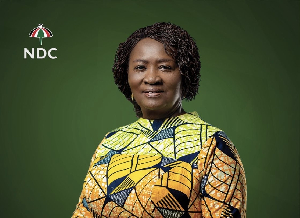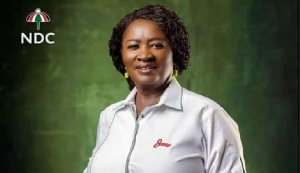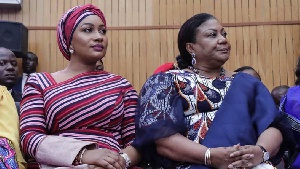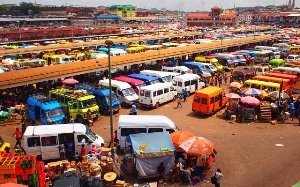 The census identified that there must be interventions that target women farmers
The census identified that there must be interventions that target women farmers
Targeting women farmers for special intervention will promote food and nutrition security, economic empowerment and general livelihood, the latest agriculture census has identified.
It stated there was the need to ensure that female smallholder farmers were sensitised to the potential financial returns on investments in agriculture and trained in general business management.
“The Ministry of Food and Agriculture should collaborate with agricultural research institutions, financial institutions and the Ministry of Gender, Children and Social Protection to provide targeted support to women in agriculture,” it said.
Agricultural activity in Ghana is dominated by arable and tree crops farming with a relatively higher proportion of females (80.6 per cent) than males (76.2 per cent) cultivate arable crops, whereas a higher proportion of males (40.1 per cent) than females (37.8 per cent) grow tree crops.
Some characteristics of female holders
According to the census, about 70 per cent of persons aged 15 years or older are engaged in a single agricultural activity. A little over one-quarter (26.5 per cent) are engaged in two different agricultural activities with the remaining 3.7 per cent engaged in three or more agricultural activities.
Proportionately, more women than men are engaged in a single agricultural activity at all ages except for the 15-19 age group.
More than 99 per cent of the population of agricultural households are Ghanaian of which females (5,643,420) are slightly more than males.
There are more females than males in agricultural households. The sex ratio is 99.8 males to 100 females. This is consistent with the 20-44 years age group and persons who are 70 years or older, whereas for sex ratio is expressed as the number of males per 100 age groups 5-19 years and 45-69 years, there are more males than females.
With regard to location, the ratio of females to males in urban areas (97.3) in agricultural households is consistent with the general sex distribution while the reverse (100.6) is the case in rural areas.
Out of the total youth in agricultural households, 51.3 per cent are males and 48.7 per cent are females.
The population aged four years or older forms 93.7 per cent of the total agricultural household population (11,340,947). Out of this number, majority have basic education (57.2 per cent), 12.1 per cent have secondary/vocational education, and only 3.1 per cent have tertiary education.
However, more than one-quarter (27.2 per cent) of the agricultural household population have never attended school. The proportion of females who have never attended school (31.5 per cent) is higher than that of males (23.0 per cent).
Generally, literacy rates are higher in urban than in rural areas and follow a similar pattern for both males and females.
The proportion of male-headed households in urban areas are two and half times that of female-headed household. In rural areas, there are three male-headed households to every female-headed household.
Crop production
Agricultural activity in Ghana is dominated by arable and tree crops farming. A relatively higher proportion of females (80.6 per cent) than males (76.2 per cent) cultivate arable crops whereas a higher proportion of males (40.1 per cent) than females (37.8 per cent) grow tree crops.
Generally, higher proportions of males than females own and use agricultural equipment. The proportion of male holders who own knapsack is more than twice as high (38.1 per cent) as females (15.2 per cent).
The proportions of male holders who use tractor, knapsack and mist blower are higher than their female counterparts by 11.1, 5.5 and 3.3 percentage points, respectively.
Of the 1,386 aquaculture holders, an overwhelming majority are males with females constituting less than five per cent across the ecological zones. The female holders in both the coastal and transitional zones rear only tilapia and not the other species. In the northern savannah zone, only tilapia is cultured and this is done by only male holders.
Marital status
In both urban and rural areas, the proportions of males who have never been married are higher than their female counterparts (by more than 9 percentage points), while widowed females in both urban and rural areas are in higher proportions (about five times higher) than their male counterparts
Females marry at an earlier age compared to males. Among age group 20-24 years, 28.1 per cent of females compared to 7.6 per cent of males are married and at age 25-35 years, 70 per cent of females are married compared to about 50 per cent of males.
Also, nearly one-third of persons 60 years or older are widowed (of which females make 53.2 per cent and males 10.8 per cent).
Conclusion
A recent report on gender budgeting by the African Centre for Energy Policy (ACEP) also recommended measures be taken to address the specific economic needs of women in agriculture.
It identified sustainable agriculture and access to capital as the recurring needs of women in agric.
“They face challenges on issues of security of land tenure and access to farmlands, access to capital and agricultural support services and access to markets, storage and processing facilities,” it said.
Therefore, access to credit for farm inputs and services such as fertilisers, seedlings and tractor services that women can access and pay back after their harvest should be provided.
“They would prefer that government supplies the subsidised fertilisers on credit and allows them to pay after the cropping season with earnings from their harvest,” the study revealed.












